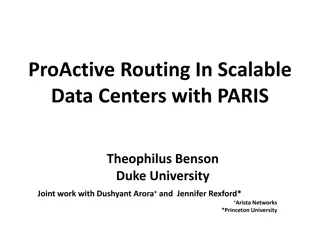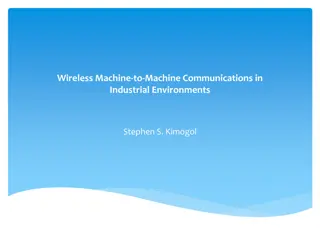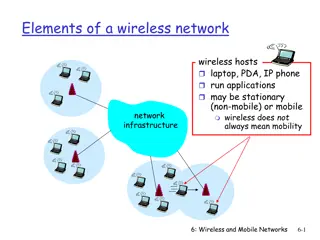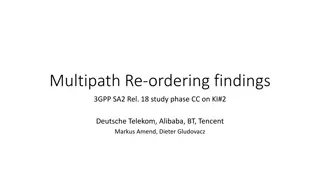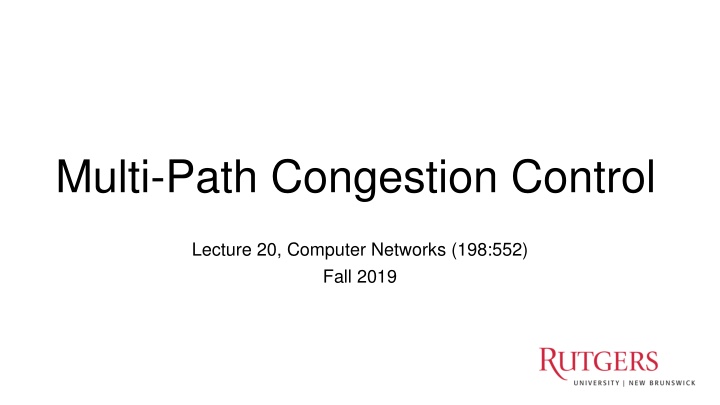
Enhancing TCP Performance with Multi-Path Congestion Control
Explore the benefits of multi-path congestion control for TCP connections, including improved resilience, higher throughput, and seamless mobility without requiring application-level changes. Learn about TCP throughput equations, steady-state behavior, AIMD models, and the goal of finding TCP throughput as a function of link rate and RTT.
Download Presentation

Please find below an Image/Link to download the presentation.
The content on the website is provided AS IS for your information and personal use only. It may not be sold, licensed, or shared on other websites without obtaining consent from the author. If you encounter any issues during the download, it is possible that the publisher has removed the file from their server.
You are allowed to download the files provided on this website for personal or commercial use, subject to the condition that they are used lawfully. All files are the property of their respective owners.
The content on the website is provided AS IS for your information and personal use only. It may not be sold, licensed, or shared on other websites without obtaining consent from the author.
E N D
Presentation Transcript
Multi-Path Congestion Control Lecture 20, Computer Networks (198:552) Fall 2019
Review: TCP congestion control Keep some in-flight (un-ACK ed) packets: congestion window Adjust window based on several algorithms: Startup: slow start Steady state: AIMD Loss: fast retransmission, fast recovery Classically, TCP uses a single path provided by the underlying network routing
If a TCP conn could use multiple paths Better resilience If one path becomes unavailable, keep traffic flowing over others Higher throughput Use multiple paths to overcome single-path bottlenecks Seamless mobility More paths as they become available, handing off as needed Example uses Mobile phone (WiFi/cellular) High-end servers (multiple NICs) Data centers (many paths available) Goal: Do all this without application-level changes
TCP throughput equation Steady-state behavior
Model of single-path TCP AIMD: W := W + 1 (RTT), W := W/2 (drop) Only a single flow using the bottleneck link Loss Congestion Window halved time
Model of single-path TCP Idealization: Repeat exactly same window evolution over multiple epochs of a single packet loss Loss Congestion Window halved Epoch time
Model of single-path TCP Window goes from Wmin to 2 * Wmin Loss rate p: number of packets dropped per packet sent Loss Congestion Window 2Wmin halved Wmin time
Model of single-path TCP Loss rate assumed to be independent of sending rate In reality: more you send, more links traversed, more you drop Loss assumed deterministic (e.g., buffer full) In reality: AQM, stochastic channel loss (e.g., cellular) Congestion Window 2Wmin halved Wmin time
Model of single-path TCP Goal: Find TCP s throughput as a function of link rate, RTT, and packet loss rate Throughput = (#packets sent per epoch) / (time per epoch) Congestion Window 2Wmin halved Wmin time
TCP throughput equation Throughput depends inversely on sqrt of loss rate, p-1/2 Throughput drops steeply with increasing loss rate Ideal: want it to be linear drop, ie: C*(1-p) Throughput depends inversely on the RTT An issue known as RTT unfairness: lower-RTT connection on a bottleneck gets higher throughput than higher-RTT connection Ideal: independent of RTT Is throughput independent of the link rate and buffer size?
Multipath TCP Design of the congestion control algorithm Slides adapted from Damon Wischik s
Goal #1: Fairness at Shared Bottlenecks A multipath TCP flow with two subflows Regular TCP Why not just open multiple TCP connections? To be fair, Multipath TCP should take as much capacity as TCP at a bottleneck link, no matter how many paths it is using.
Goal #2: Use Efficient Paths 12Mb/s 12Mb/s 12Mb/s Each flow has a choice of a 1-hop and a 2-hop path. How should each flow split its traffic?
Use Efficient Paths 12Mb/s 8Mb/s 8Mb/s 12Mb/s 8Mb/s 12Mb/ s Equal-window TCP (EWTCP): split flow traffic 1:1 over paths Achieve fairness using Ws := Ws + a (RTT), a < 1
Use Efficient Paths 12Mb/s 9Mb/s 9Mb/s 12Mb/s 9Mb/s 12Mb/s Move some traffic to better paths: What if each flow split its traffic 2:1?
Use Efficient Paths 12Mb/s 12Mb/s 12Mb/s 12Mb/s 12Mb/s 12Mb/s Best: Each connection on its one-hop path Least congested path
Use Efficient Paths 12Mb/s 12Mb/s 12Mb/s 12Mb/s 12Mb/s 12Mb/s Goal: Get each flow to send all its traffic on the least- congested path Achieve by coupling the subflow TCP window updates Ws := Ws + 1/Wtotal (ack), Ws := Ws Wtotal/2 (drop)
Use Efficient Paths 12Mb/s 12Mb/s 12Mb/s 12Mb/s 12Mb/s 12Mb/s Ws := Ws + 1/Wtotal (ack), Ws := Ws Wtotal/2 (drop) Consequence: the more drops a subflow sees, the faster its window Ws reduces (note: increments same across all paths) More lossy paths have zero window in the limit
Use Efficient Paths 12Mb/s 12Mb/s 12Mb/s 12Mb/s 12Mb/s 12Mb/s Ws := Ws + 1/Wtotal (ack), Ws := Ws Wtotal/2 (drop) Consequence: Remaining paths have balanced loss rate equal window if RTTs same If loss not balanced, window would drop to zero
Coupled CC can get trapped Keep a little traffic on each path (even if congested) to probe for capacity always i.e., keep your options open
Coupled CC can get trapped Semi-coupled TCP Ws := Ws + a/Wtotal (ack), Ws := Ws Ws/2 (drop) Compare with coupled: Ws := Ws + 1/Wtotal (ack), Ws := Ws Wtotal/2 (drop)
Goal #3: Be Fair Compared to TCP Least-congested paths may not be best Low loss rate, but low throughput due to differences in RTT Example: Two paths WiFi: high loss, low RTT Cellular: low loss, high RTT Using the least-congested path Choose the cellular path, due to low loss But, the RTT is high So throughput is low! Formalize fairness requirement using actual throughput
Be Fair Compared to TCP To be fair, Multipath TCP should give a connection at least as much throughput as it would get with a single-path TCP on the best of its paths, given the same loss rate Ensure incentive for deploying MPTCP A Multipath TCP should take no more capacity on any path (or collection of paths) than if it was a single-path TCP flow using the best of those paths, given the same loss rate Do no harm
Achieving These Goals Regular TCP Maintain a congestion window w On an ACK, increase by 1/w (increase 1 per window) On a loss, decrease by w/2 MPTCP Maintain a congestion window per path ws On an ACK on path s, increase ws On a loss on path s, decrease by ws/2 How much to increase ws on an ACK? If s is the only path at that bottleneck, increase by 1/ws
If Multiple Paths Share Bottleneck? Don t take any more bandwidth on a link than the best of the TCP paths would But, where might the bottlenecks be? Multiple paths might share the same bottleneck This is hard to know across the Internet So, consider all possible subsets of the paths Set R of paths Subset S of R that includes path r E.g., consider path 3 Suppose paths 1, 3, and 4 share a bottleneck but, path 2 does not Then, we care about S = {1,3,4}
Achieving These Goals What is the best of these subflows achieving? Path s is achieving throughput of ws/RTTs So best path is getting maxs(ws/RTTs) What total bandwidth are these subflows getting? Across all subflows sharing that bottleneck Sum over s in S of ws/RTTs Consider the ratio of the two Increase by less if many subflows are sharing And pick the results for the set S with min ratio To account for the most paths sharing a bottleneck
Implementation Issues Buffer space: per-subflow or shared for entire connection? Reassembly across multiple paths Different sequence spaces across subflows But shared flow control Ensure packets across subflows reach at approx. the same time Middleboxes Avoid impact due to rewritten sequence numbers Initiating new subflow: new TCP flag; auth token



